Science fiction films have imagined many futuristic or fantastical technologies and scientific innovations outside our immediately attainable reach. Nevertheless, the essence of science fiction is rooted in the science of the present, or at least based on the scientific information available at the story’s inception. An interstellar space ship, for example, is not a reality of the present, but a science fiction film from the 1950s and one from the 1990s will have drastic variations on the same basic premise. One could argue budgetary concerns and filmmaking conventions relative to each time-period, but, more so than that, our knowledge of space and technology has changed so drastically between those time-periods that our approaches to realism in science fiction evolves along with that knowledge. Unlike robots, space ships, and cyborgs, one science fiction innovation that is still very much beyond our technological capabilities is that of time travel.
Almost all scientific notions of time travel are still very much theoretical. In fact, “most physicists view time travel as being problematic, if not downright repugnant.” [1] The only proven method of time travel came years after Einstein’s theories on relativity. In 1971, scientists used atomic clocks to test Einstein's theory that time slows relative to speed. One clock was set up on the ground while another was sent around the world on a jet traveling at 600 mph. At the start, both clocks showed exactly the same time, but by the end, the clock on the jet was off by a few billionths of a second. [2] So, while it is theoretically possible to travel to the future, the inability to reach light-speeds precludes the ability to do so realistically.
Travelling backwards in time, however, is not as provable – although not necessarily un-provable. Peering into the past, on the other hand, may be a more realistically provable approach. Renowned astrophysicist J. Richard Gott notes that every time one peers into a telescope to look at the stars, they are in fact looking at light that has travelled here from millions or billions of years in the past. He even notes that every time you look into a mirror from five feet away, you are looking at yourself from 10 nanoseconds in the past. [3] Theories that would allow one to physically travel to the past would include the use of wormholes or other various ruptures in space-time. [4]
While stories involving travels or glimpses into the future have been around for centuries, stories involving travelling to or peering into the past weren’t around much before Charles Dickens’ A Christmas Carol in 1843. Science fiction films started featuring time-travel as a plot device with the adaptation of H.G. Wells’ The Time Machine in 1960. By the 1980s, time-travel had become a popular convention within science fiction in addition to many other genres, as well.
One film that dealt primarily with travelling to the past was Back to the Future (Robert Zemeckis, 1985, USA). Marty McFly, through the accidental use of a time machine in the form of a DeLorean automobile, travels backwards in time from the year 1985 to the year 1955. While the DeLorean gets nowhere near the speed of light necessary to significantly alter the passage of time, the fact that Marty is travelling backwards in time excludes the necessity of faster-than-light travel. Although a speed of 88 mph needs to be reached to ‘spark’ the time travel mechanism, the film proposes that plutonium is the real catalyst needed to facilitate the travel through time. The special effects in the film would suggest that the way in which the DeLorean travels through time is by creating a rift between to points in time, allowing the DeLorean pass through from one time-period to another. Marty drives through the rift and immediately appears in 1955 with the machine maintaining momentum and continuing on its previous path.
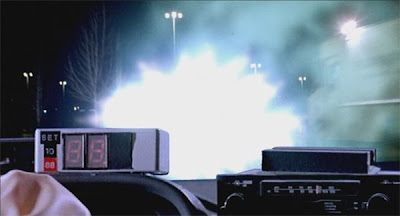 Star Trek: First Contact (Jonathan Frakes, 1996, USA) posits a similar version of time travel. The Borg - a race of cybernetic organisms that unfalteringly assimilates other races into their collective – make use of time travel to alter the continuity of the current time-line by assimilating Earth in the past. Julia Witwer notes that “no one knows for sure what kind of people the Borg were before they became their own technology.” [5] How fitting is it then that this species, seemingly without origin, travels in time to disrupt the origins of the Federation? Upon destruction of its mother ship, a Borg “sphere” makes its way towards Earth. The sphere emits “chronometric particles” to open a “temporal vortex,” opening a portal to the past. The Enterprise gets caught in the vortex’s wake, shielding it and its crew from the changes that, relative to their own timeline, would have already happened. Similar to BTTF, when the Enterprise travels through the vortex, it is instantaneously transported from the 24th to the 21st century.
Star Trek: First Contact (Jonathan Frakes, 1996, USA) posits a similar version of time travel. The Borg - a race of cybernetic organisms that unfalteringly assimilates other races into their collective – make use of time travel to alter the continuity of the current time-line by assimilating Earth in the past. Julia Witwer notes that “no one knows for sure what kind of people the Borg were before they became their own technology.” [5] How fitting is it then that this species, seemingly without origin, travels in time to disrupt the origins of the Federation? Upon destruction of its mother ship, a Borg “sphere” makes its way towards Earth. The sphere emits “chronometric particles” to open a “temporal vortex,” opening a portal to the past. The Enterprise gets caught in the vortex’s wake, shielding it and its crew from the changes that, relative to their own timeline, would have already happened. Similar to BTTF, when the Enterprise travels through the vortex, it is instantaneously transported from the 24th to the 21st century.
 The Terminator (James Cameron, 1984, USA) features an inventive method of time travel that is unique to the franchise. While the DeLorean and the Enterprise were machines that were necessary for successful time travel, The Terminator’s method of time travel prohibits the use of machinery; only organic matter can make the transition through time. In order for a machine like the Terminator to make use of time travel, it first needs to be enclosed in organic material or, to be more precise, skin. In a way, this method is the opposite of the ones mentioned prior. Instead of machines housing organisms, machines are housed within organic material. Also unlike the other two films, the act of time travel doesn’t seem to be limited to time travel alone, but travel through space and time. Under the assumption that there is only one stationary time-traveling device, both Reese and the Terminator enter the past at different locations on the map. While the exact process of time travel is handled off-screen, the audience is made aware of the electro-magnetic disturbances that precede the time-travel event.
The Terminator (James Cameron, 1984, USA) features an inventive method of time travel that is unique to the franchise. While the DeLorean and the Enterprise were machines that were necessary for successful time travel, The Terminator’s method of time travel prohibits the use of machinery; only organic matter can make the transition through time. In order for a machine like the Terminator to make use of time travel, it first needs to be enclosed in organic material or, to be more precise, skin. In a way, this method is the opposite of the ones mentioned prior. Instead of machines housing organisms, machines are housed within organic material. Also unlike the other two films, the act of time travel doesn’t seem to be limited to time travel alone, but travel through space and time. Under the assumption that there is only one stationary time-traveling device, both Reese and the Terminator enter the past at different locations on the map. While the exact process of time travel is handled off-screen, the audience is made aware of the electro-magnetic disturbances that precede the time-travel event.
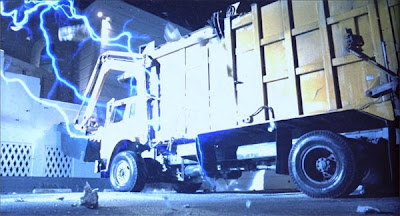 While the act of time-travel varies in each film, all operate within various notions of predestination paradoxes, or, to put it another way, “events that [predestine them] to travel back in time.” [6] While in the past, Marty plays Chuck Berry’s song “Johnny B. Goode” which in turn inspires Chuck Berry to write that very same song. In The Terminator, Kyle Reese is sent back in time by John Connor to protect John’s mother. What’s interesting is that Kyle is in fact John’s father, bringing up the question of how John could have sent him back to save his mother in the first place seeing as John couldn’t have existed without Kyle having a reason to travel to the past. This would even eliminate the Terminators’ need to create a time-travelling device to begin with. ST:FC avoids some of these paradoxes with the Enterprise being shielded within the “temporal wake,” protecting it from changes in the timeline. Nevertheless, there is the paradox of the crew helping to launch the first warp ship – the basis of their 24th century existence.
While the act of time-travel varies in each film, all operate within various notions of predestination paradoxes, or, to put it another way, “events that [predestine them] to travel back in time.” [6] While in the past, Marty plays Chuck Berry’s song “Johnny B. Goode” which in turn inspires Chuck Berry to write that very same song. In The Terminator, Kyle Reese is sent back in time by John Connor to protect John’s mother. What’s interesting is that Kyle is in fact John’s father, bringing up the question of how John could have sent him back to save his mother in the first place seeing as John couldn’t have existed without Kyle having a reason to travel to the past. This would even eliminate the Terminators’ need to create a time-travelling device to begin with. ST:FC avoids some of these paradoxes with the Enterprise being shielded within the “temporal wake,” protecting it from changes in the timeline. Nevertheless, there is the paradox of the crew helping to launch the first warp ship – the basis of their 24th century existence.
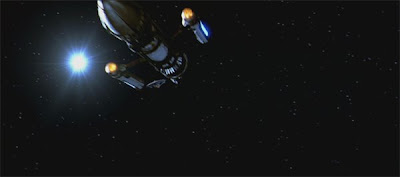 The consequences of time travel are also varied in every film mentioned, as well. Although BTTF and The Terminator are both facilitated by the use of or in consequence of nuclear materials, the interferences in the past for each film differ. With BTTF, anyone that Marty interacts with could have potential consequences in his own space-time, making the act of time travel all the more dangerous. With The Terminator, however, as long as Sarah Connor survives, any other interferences would be, at best, inconsequential to Kyle’s timeline as most of humanity has been extinguished already. Both movies, though, work with the idea of the devastating effects of radioactive materials and nuclear proliferation.
The consequences of time travel are also varied in every film mentioned, as well. Although BTTF and The Terminator are both facilitated by the use of or in consequence of nuclear materials, the interferences in the past for each film differ. With BTTF, anyone that Marty interacts with could have potential consequences in his own space-time, making the act of time travel all the more dangerous. With The Terminator, however, as long as Sarah Connor survives, any other interferences would be, at best, inconsequential to Kyle’s timeline as most of humanity has been extinguished already. Both movies, though, work with the idea of the devastating effects of radioactive materials and nuclear proliferation.
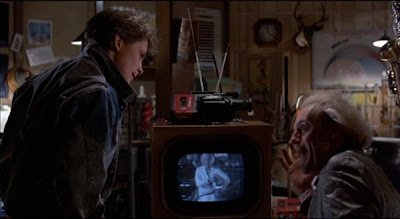 In ST:FC, the Federation has rules in place to avoid or, at least, minimize their interferences in the past. While the Federation presumably doesn’t actively seek out methods of time travel, the vastness and unpredictability of space has presented opportunities for such travels. In this instance, their failure to change the past would have negated their very existence. With the Borg, one could make the connection of the dangers of the over-assimilation, so to speak, of modern technology along with the dangers of being too reliant on technology.
In ST:FC, the Federation has rules in place to avoid or, at least, minimize their interferences in the past. While the Federation presumably doesn’t actively seek out methods of time travel, the vastness and unpredictability of space has presented opportunities for such travels. In this instance, their failure to change the past would have negated their very existence. With the Borg, one could make the connection of the dangers of the over-assimilation, so to speak, of modern technology along with the dangers of being too reliant on technology.
Science fiction provides many unique views and interpretations in regards to theories of time travel. While time travel is mostly still rooted in theories, the magic of science fiction is that it can imagine many different ways to tackle the same issue. The differences in execution are directly rooted to scientific knowledge relative to the work’s time period. This is, in fact, the great promise of science fiction; its ability to transport us convincingly into these fantastic realms. [7]
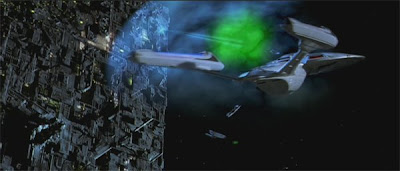 Endnotes:
Endnotes:[1] Gibbons, G.W., E. P. S. Shellard, and S. J. Rankin, eds. “The Quantum Physics of Chronology Protection.” The Future of Theoretical Physics and Cosmology: Celebrating Stephen Hawking's 60th Birthday. (New York: Cambridge UP, 2003) p. 163.
[2] "Einstein's Big Idea." PBS. 10 May 2009
[3] Gott, J. Richard. “You Can See the Past.” Time Travel in Einstein's Universe: The Physical Possibilities of Travel Through Time. (New York: Mariner Books, 2002) pp. 76-77.
[4] Ciufolini, Ignazio, Daniele Dominici, and Luca Lusanna, eds. “Physics in the Presence of a Time Machine.” 2001 A Relativistic Spacetime Odyssey. (Chicago: World Scientific Pub Co Inc, 2003) pp. 89-90.
[5] Witwer, Julia. “The Best of Both Worlds: On Star Trek’s Borg.” Prosthetic Territories: Politics and Hypertechnologies. Ed. Gabriel Brahm and Mark Driscoll. (Boulder: Westview Press, 1995) p. 271.
[6] Icon Group International, Inc. Staff, comp. Grandfathers: Webster's Quotations, Facts and Phrases. (Icon Group International, Inc., 2008) p. 213.
[7] J. P. Telotte. “Introduction: The World of the Science Fiction Film,” Science Fiction Film. (New York: Cambridge UP, 2001) p. 28.
Works Cited
Back to the Future. Dir. Robert Zemeckis, Perf. Michael J. Fox, Christopher Lloyd and Lea Thompson. 1985. DVD. Universal Pictures, 2002.
Ciufolini, Ignazio, Daniele Dominici, and Luca Lusanna, eds. 2001 A Relativistic Spacetime Odyssey. Chicago: World Scientific Pub Co Inc, 2003.
"Einstein's Big Idea." PBS. 10 May 2009
Gibbons, G.W., E. P. S. Shellard, and S. J. Rankin, eds. The Future of Theoretical Physics and Cosmology: Celebrating Stephen Hawking's 60th Birthday. New York: Cambridge UP, 2003.
Gott, J. Richard. Time Travel in Einstein's Universe: The Physical Possibilities of Travel Through Time. New York: Mariner Books, 2002.
Icon Group International, Inc. Staff, comp. Grandfathers: Webster's Quotations, Facts and Phrases. Icon Group International, Inc., 2008.
Star Trek: First Contact. Dir. Jonathan Frakes, Perf. Patrick Stewart, Brent Spiner, and James Cromwell. 1996. DVD. Paramount, 2005.
Telotte, J. P., and Barry Keith Grant. Science Fiction Film. New York: Cambridge UP, 2001.
Terminator, The. Dir. James Cameron, Perf. Arnold Schwarzenegger, Michael Biehn and Linda Hamilton. 1984. Blu-ray. MGM, 2006.
Witwer, Julia. Prosthetic Territories: Politics and Hypertechnologies. Ed. Gabriel Brahm and Mark Driscoll. Boulder: Westview Press, 1995.














